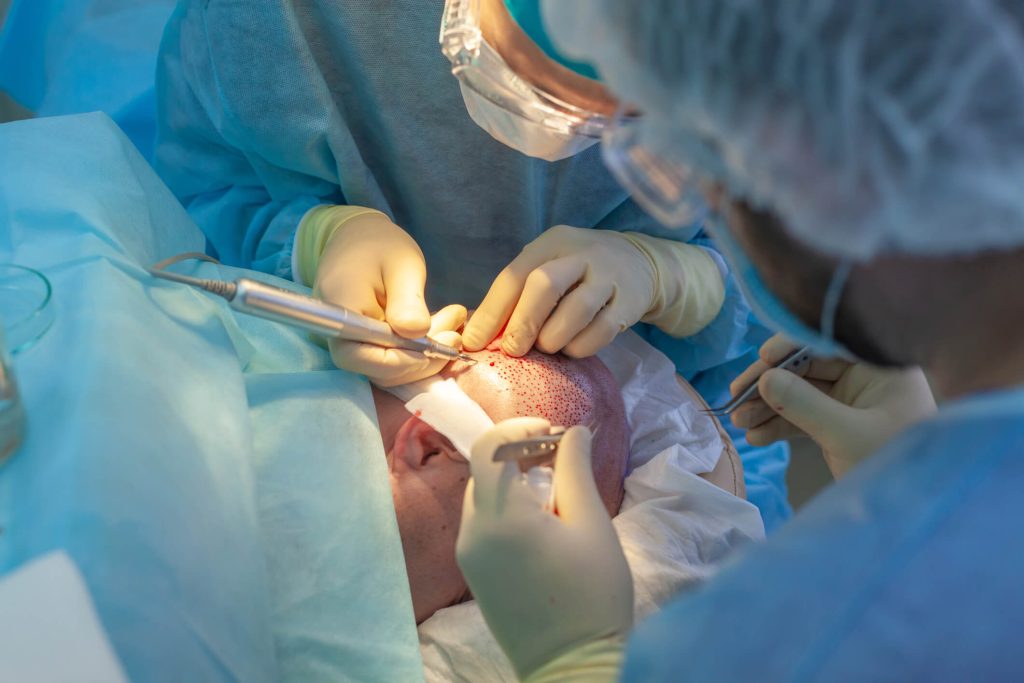Although undergoing a hair transplant to treat a receding hairline could appear to be an extreme approach to some, it is unquestionably the most effective treatment option. Most men find receding hair surprising, especially if it occurs when they are young. However, modern techniques for treating the hairline and temples are now available courtesy of science and research, including Follicular Unit Extraction (FUE).
Men and women can avoid the embarrassment of turning bald or losing that crucial front hair thanks to hair restoration surgery. The main reasons for receding hairlines, the effectiveness of surgeries, the principles of FUE, as well as the associated costs will all be covered in detail in this article.
What Causes Receding Hairlines?
Age is the main factor contributing to a receding hairline. Genetics, hormones, and responses to chemicals or medications are among additional determining factors. It’s a well-known fact that body hair falls out as you age, and this also applies to your head’s hair.
Most males over 50 experience hair loss, according to data from the US National Library of Medicine (NLM). However, there are instances of males losing their hair before the age of 40, and some even start losing it as teenagers. You might likely attribute it to additional causes in these circumstances, like:
- Hormones. Both women and men might have hair loss as a result of hormonal issues. For instance, when a man has DHT-sensitive hair follicles (Dihydrotestosterone), a condition called male pattern baldness occurs.
- Genetics. You have a larger likelihood of developing baldness if there are family members with receding hairlines or perhaps balding. Most people who start losing their hair at an early age have genetic causes for the problem.
- Reactions to certain medications, chemicals, or treatment. Hair loss can occasionally be the result of an unfavorable reaction to medications, creams, or perhaps even hair loss treatments. Everybody has a unique set of genes, skin types, and allergies. It’s frequently better to continue using a specific hair shampoo or cream that is effective for you.
- Lifestyle. Hair loss can be brought on by bad habits including drinking alcohol and smoking.
- Stress. Your body can suffer from too much stress in a number of ways. Long-term stress brought on by ailments or difficult work can lead you to have temporary hair loss or perhaps a receding hairline.
The Importance of Hairline Design
The hairline design is crucial in all hair transplantations, but it is particularly crucial in hair transplants at the hairline. The hairline will become permanent and may appear fake if applied incorrectly. Nobody wants an abrupt, unnatural hairline that resembles a poor wig.
It takes more than just medical and technical knowledge to create a good hairline. Additionally needed are a great deal of accuracy, a steady hand, and an aesthetic and artistic mindset.
The following things should be taken into account while developing a hairline:
- Patients gender. Depending on the patient’s gender, the new hairline will take on a different shape. Women typically have a straighter line, whereas men typically have a more curved line.
- Forehead Muscles. The area of the forehead where the grafts should be placed lacks muscles.
- Age. With aging, the hairline naturally recedes. If an older patient’s hairline is as low as a young man’s, the result will look unnatural and wig-like.
- Forehead width. Depending on how broad the forehead is, the doctor will choose how round and curled the hairline will be.
- Hair Direction. You must always adjust to the natural angle as well as the direction of the hair for a successful hair transplant. The hairline must be designed with the hair placed in a zigzag pattern rather than in a straight line.
- Patient preferences. To effectively fulfill the patient’s wants and preferences, the surgeon must always inquire about his or her options. They will decide on the best course of action together.
What Solutions Are There for Restoring a Receding Hairline?
Although there is no simple treatment for its receding hairline, vitamin supplements and topical prescription medications can help to halt it and encourage hair growth. FUE hair transplant surgery is one option that is quickly gaining popularity and has a high success rate.
Treatment options
A receding hairline is irreversible, but there are several drugs which might halt it and encourage hair growth.
Dutasteride or Finasteride
DHT, which is produced when testosterone is converted in males, can result in hair loss on the head of a man.
Finasteride is marketed as the brand name Propecia. It is a medical prescription made specifically to treat male-pattern baldness.It slows down the rate at which testosterone transforms into DHT, hence lowering DHT levels in the body.
Some men may find it simpler to develop hair or see less hair loss as a result. Although it is created to treat the enlarged prostate, the medication Dutasteride (Avodart) is frequently employed to help promote hair growth and repair.
Usually, these side effects disappear as soon as the individual stops taking the medication.
Minoxidil
The American Food and Drug Administration (FDA) has approved the over-the-counter scalp medication minoxidil (Rogaine) to help decrease the rate of hair loss. The effects normally remain for the duration of the course of treatment, but if the person stops using it, baldness will return.
Hair transplants and laser therapy
In order to fill in the thinning hairline, a hair transplant entails transplanting hair and chunks of scalp from thicker areas of the head to the front. Although the procedure is pricey, many individuals think it’s a more durable solution for a receding hairline.
Some patients may notice an improvement in hair growth and a decrease in male pattern baldness when undergoing laser therapy utilizing red light or a laser with a 660 nm wavelength.
How Effectively Do Hair Transplants Work?
Hair transplants can be an effective way to restore hair for people with hair loss. The success of the procedure depends on various factors, including the extent of hair loss, the quality of the donor’s hair, and the skill of the surgeon performing the transplant.
In general, hair transplants have a high success rate, with most people experiencing significant hair growth after the procedure. However, it’s important to keep in mind that individual results can vary, and some people may require multiple sessions to achieve their desired outcome.
What Hair Transplant Procedure is Most Effective for a Receding Hairline?
Although there are several different hair transplant techniques, Follicular Unit Extraction (FUE) represents the most advanced. Since it recreates the hairline by extracting the hair transplants one at a time, this procedure results in seamless results. The FUT (Follicular Unit Transplantation) procedure is a strong competitor to the FUE hair transplantation method.
How does FUE hair transplant work?
In a hair transplant process called Follicular Unit Extraction (FUE), donor hair are removed from denser areas and relocated to areas with partial or complete hair loss. In contrast to other procedures, this one removes each hair follicle one at a time, leaving minimal to no evidence of the procedure.
Normally, the freshly transplanted hair falls out in 2 to 3 weeks. The follicles are still present and continuing to take root, so this is typical and not alarming. Patients will notice new hair growth a few weeks later (about 3 months after surgery).
Pros of Follicular Unit Extraction technique
FUE hair transplants can be used to treat many types of hair loss, and noticeable results are often visible in 3 to 4 months. Other benefits are:
- a comfortable and pleasant procedure
- Quick recovery
- Scars are nearly unnoticeable.
- 90% of hair grafts survive.
What is the Recovery Time After a Follicular Unit Extraction Operation?
Your wounds from the Follicular Unit Extraction treatment heal in 3 to 5 days. However, it takes 2 – 3 weeks to fully recover. At this point, hair begins to fall out, a sign of follicle growth. The mature stage of implanted hair growth takes 3 to 4 months.
How Safe is Hair Transplant Surgery?
When performed by a qualified, experienced, and board-certified plastic surgeon, hair transplant surgery is typically safe. Although discomfort, swelling, and inflammation of the scalp may persist for several hours, minutes, or days following the procedure, much like with other surgical procedures. At the beginning of your recovery, they are common side effects, but they shouldn’t worry you too much. On the other hand, picking an unskilled doctor can lead to severe wounds and infections. Working with a trustworthy, licensed physician like Dr. George Brennan is essential.
Benefits of Hair Transplant
Hair transplant is a medical treatment involving the transplantation of hair follicles part of the scalp to another, usually the back or sides, to an area where hair has thinned or fallen out. Here are some potential benefits of a hair transplant:
- Restores hair: Hair transplant is an effective way to restore hair in areas where baldness or thinning has occurred, giving the patient a fuller and more youthful head of hair.
- Natural-looking results: Hair transplant surgery produces natural-looking results, with the transplanted hair blending seamlessly with the patient’s existing hair.
- Long-lasting: Hair transplant surgery is a permanent solution to hair loss. When the transplanted hair follicles establish themselves, they will continue to grow like natural hair.
- Low-maintenance: The transplanted hair can be treated like the patient’s natural hair, requiring no special maintenance or care.
- Boosts self-esteem: Hair loss can be a significant source of embarrassment and self-consciousness for many people. Restoring hair through hair transplant surgery can boost self-esteem and confidence.
- Cost-effective: While hair transplant surgery can be initially expensive, it is a one-time cost that is more cost-effective than long-term hair loss treatments like hair growth medications and hair replacement systems.
- Minimal scarring: Hair transplant surgery uses minimally invasive techniques, which can result in minimal scarring and a faster recovery time compared to other surgical procedures.
It’s worth noting that not everyone is a good candidate for hair transplant surgery, and results may vary depending on the individual’s case. It’s important to consult with a qualified surgeon to determine if a hair transplant is the right option for you.
Will I Need a Second Hair Transplant?
When men with early male pattern baldness see a receding hairline, they undergo hair transplant surgery. Even after a hair transplant, androgenetic alopecia might persist, leading to new balding or thinning areas and, in some situations, necessitating a second hair transplant.
As a result, it’s crucial to carefully plan the surgery for when the alopecia seems stable rather than rapidly progressing.
In order to avoid the necessity for a second hair transplant in the near future or within a few years, a doctor should and will be able to determine the stage at which the hair loss is progressing.
Cost of a Hair Transplant for a Receding Hairline
The average cost of a hair transplant varies widely and is often between $4,000 to $15,000. Many times, no one is reimbursed for these expenses. The majority of insurance providers classify hair transplants as aesthetic procedures.
The following factors affect the cost of hair transplants:
- Where you live. What a surgeon charges can be influenced by the local cost of living and the availability of other surgeons who perform the surgery close by.
- The kind of procedure you select. Follicular unit extraction (FUE) and Follicular unit transplantation (FUT) are the two methods used to transplant hair. Each comes at a different price.
- The skill of a surgeon. It is a well-known link that if a surgeon is regarded as one of the greatest, they might charge more. However, higher rates don’t automatically indicate greater expertise, so you should do your homework.
- Your desired hair transplantation amount. It will be substantially less expensive to want a couple of patches added than to want more hair all over the scalp.
- Travel costs. Although your doctor won’t charge for this, it is a cost you should take into account. To locate the best doctors, you occasionally have to travel, and the cost of doing so may affect your choice about whether you are able to afford the surgery.
Conclusion
Overall, hair transplantation is a safe and effective procedure to address receding hairlines. It can provide immediate results, restoring a fuller and more youthful look to the scalp. The process is relatively straightforward, and the results can last for many years. Moreover, it offers a permanent solution to any hair loss issues, meaning that you will not have to worry about your hairline receding again. If you are considering having a hair transplant to address your receding hairline, it is important to seek professional advice from an experienced and qualified doctor. They will be able to assess your individual situation and advise you on the best course of action.
Take Action Against Your Receding Hairline
If you’re tired of watching your hairline slowly disappear, it’s time to take action. Don’t let your receding hairline define your appearance and self-confidence. With our help at Neograft Hair Restoration Orange County, you can take control and start fighting back against hair loss. Whether you’re looking for a hair growth treatment, an Orange County hair transplant, or other options, we can help you find the solution that’s right for you. If you have any questions or want to know more information, schedule an appointment or consultation with us or you may call us at (949) 644-3592.
FAQs: Is It Worth Getting a Hair Transplant if You Have a Receding Hairline?
1. What is the best age to get a hair transplant for a receding hairline?
While hair transplants can be performed at any age, it’s generally better to wait until the hair loss has stabilized. This usually happens in your late 20s or early 30s, as hair loss may continue after the procedure if it’s still in an early stage.
2. How do I know if I’m a good candidate for a hair transplant?
Ideal candidates have sufficient donor hair in areas like the back or sides of the scalp. Additionally, the patient should be healthy and have realistic expectations about the procedure’s results.
3. Are there non-surgical alternatives to a hair transplant for treating a receding hairline?
Alternatives like medications (Finasteride, Minoxidil), laser therapy, and lifestyle changes can help slow hair loss or promote regrowth. However, these options may not provide the permanent results a hair transplant can offer.
4. Can a hair transplant fix a receding hairline on women and men?
Yes, both men and women can benefit from hair transplants. However, the approach to hairline design and transplant technique may differ slightly based on gender and the unique pattern of hair loss.
5. How does the hairline design differ between men and women?
Men generally have a more curved, natural hairline, while women typically have a straighter line. A skilled surgeon will tailor the design to suit each individual’s facial features and gender-specific hair loss patterns.
6. Can a hair transplant result in permanent hair regrowth?
Yes, a hair transplant provides a permanent solution. Once the transplanted follicles establish themselves in the thinning area, they will grow like natural hair for a lifetime.
7. What are the potential side effects of a hair transplant procedure?
Side effects can include mild swelling, redness, and scabbing around the donor and recipient areas. After the procedure, there may also be temporary hair shedding, but this is normal as the new hair follicles begin to take root.
8. How long do the results of a hair transplant last?
The results of a hair transplant are typically long-lasting and permanent. However, hair loss may continue in untreated areas of the scalp, which could require further treatment or a second procedure.
9. Will a hair transplant affect my lifestyle?
Most patients can return to their normal activities after the initial recovery period, which usually lasts a few weeks. However, strenuous exercise and activities that cause excessive sweating should be avoided in the early weeks post-surgery.
10. How do I maintain my hair after a transplant to ensure the best results?
Following a hair transplant, it’s important to follow your surgeon’s post-operative care instructions, avoid direct sun exposure, use recommended shampoos, and take any prescribed medications. Consistent maintenance of a healthy lifestyle also supports long-term hair health.














